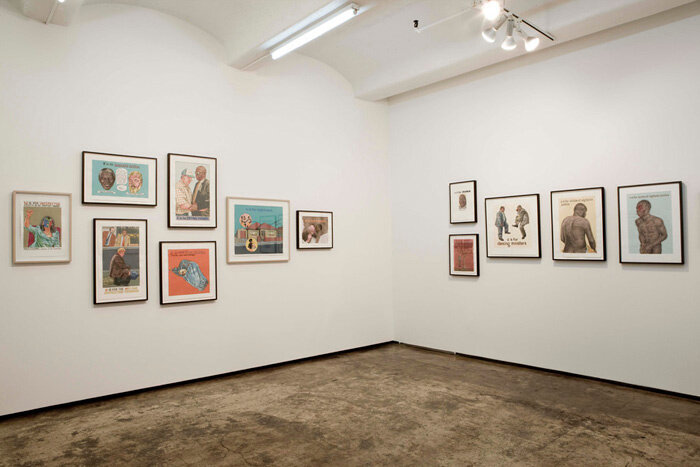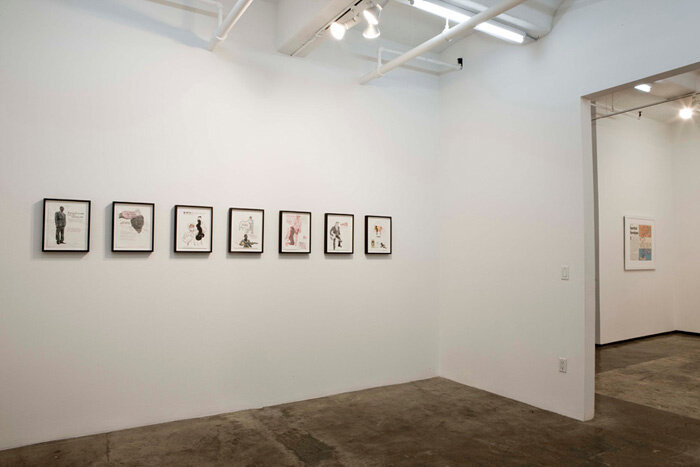The Haunt Of Fears
Press Release
ANTON KANNEMEYER
The Haunt of Fears
Thursday, April 17 – May 17, 2008
Opening reception for the artist; Thursday, April 17th from 6 to 8 pm
Jack Shainman Gallery is pleased to announce The Haunt of Fears, an exhibition of new works by Anton Kannemeyer. Taking its name from the 1950s EC Comics title (The Haunt of Fear), the exhibition pays homage to the tradition through which Kannemeyer made his name, comic art. As co-editor of Bitterkomix, the satirical comic magazine he started with Conrad Botes in 1992, Kannemeyer became known for creating an influential new South African brand of biting socio-political satire. Here Kannemeyer presents selections of works on paper from The Alphabet of Democracy-series, a new series entitled Cursed Paradise and drawings from recent sketch books; all of which elaborate on the tradition of comic art to voice more complex concerns in response to an ever changing cultural and socio-political landscape in southern Africa.
In his large ongoing work-in-progress The Alphabet of Democracy, the first pieces of which he unveiled in the 2005 exhibition Days of My Lives, Kannemeyer has turned his focus from the sins, perversions and sexual repression of the fathers to the bigger post-Apartheid picture.The Alphabet still sharply comments on the madness directly below the surface of the rabidly conformist parts of white South African society, especially the Afrikaans community.But as its title indicates, it is also concerned with the current mutations of bigotry bred by political correctness, financial greed and the hollow rainbow and renaissance rhetoric of a new political hierarchy.The use of the word “democracy” becomes subversive in the context of this layered artwork that portrays the liberated South African society and its form of government as just another arbitrary social order fraught with moral ambiguity and human absurdity.Kannemeyer tackles a lot of issues politicians and journalists tent to shy away from by using a mixture of the stereotypes associated with political cartooning and combining them with the deeply personal, the irreverent and the surrealism of the subconscious.His idiosyncratic mash-up of allegory, history, existentialist nausea, self-loathing and nihilism makes for a heady brew.
In the Cursed Paradiseseries and pieces such as "N is for nightmare" and "Pappa in Afrika" Kannemeyer take political satire a risky step further into the murky depths of white fear.Where the Oscar winning Tsotsi was careful to emphasize the humanity of the characters perpetrating violence and crime, the Nightmare piece paints a nastier picture.Fear and anxiety, like the libido, has never been politically correct.To fear someone or something implies that you believe they mean you harm.The figures stalking the dreams of the sleeping suburb portrayed here are not the sympathetic victims of poverty and previous disadvantagement.They are deliberately rendered as savages reminiscent of Herge’s depiction of “the natives” in the controversial Tintin in the Congo.These nightmare images are at awkward odds with the polite noises any progressive white liberal would make during dinnertime conversation.
The use of Tintin as a satirical character, as seen in the parody of Tintin in the Congo, is poignant in more ways than one.Kannemeyer has used a Tintin-like figure to portray himself, or at times the white Afrikaans boy running, before – for example in True Love (Best of Bitterkomix, 1998) and the haunting 1974 (Best of Bitterkomix, 2002).In doing so he pays ambivalent homage to Herge, his morally tainted comic artist hero, and to Tintin, the hero of his naïve white and privileged childhood.He also immediately engages with the ongoing post-colonial discourse and the controversy surrounding highly influential narratives, for example Joseph Conrad’s Heart of Darkness, which are now seen by acclaimed writers like Chinua Achebe as deplorable proof of the colonial mindset and its cultural imperialism.In Kannemyer’s work Tintin is a white African trapped in his own incriminating skin - a character who cannot escape his colonial past regardless of his personal political convictions.
Wallace Stevens famously described poetry as “a violence from within that protects us from a violence without.”The art of Anton Kannemeyer is clearly a violence from within, but it does not seem to believe in any form of protection or anything but the need for individual resistance against the pressures of an unrelenting reality.His work is a head-on collision with the national state of desperate confusion.This new collection of works will make the viewer nervous, then laugh, and then make him nervous all over again.
For further information or press photography please contact the gallery at info@jackshainman.com.


